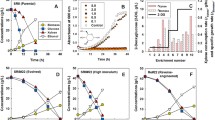Abstract
The glucose analog 2-deoxyglucose (2-DOG) has been used to obtain mutants depressed for pentose metabolism. Some researchers have used 2-DOG alone whereas others have used it in the presence of a glucose-repressible carbon source. We examined both methods and screened mutant strains for improved use of xylose in the presence of glucose. Pichia stipitis mutants selected for growth on d-xylose in the presence of 2-DOG used xylose from a 1∶1 glucose:xylose mixture more rapidly than did their parents. One of these mutants, FPL-DX26, completely consumed xylose in the presence of glucose and produced 33g/L ethanol in 45h from 80 g/L of this sugar mixture. Mutants selected for growth on 2-DOG alone did not show significant improvement. Selection for growth on d-xylose in the presence of 2-DOG has been useful in developing parental strains for further genetic manipulation.
Similar content being viewed by others
Abbreviations
- μ:
-
Specific growth rate (/h)
- Rs:
-
volumetric sugar uptake rate (g/L/h)
- Qs:
-
specific sugar uptake rate (g/g/h)
- Rpe:
-
volumetric ethanol production rate (g/L/h)
- Qpe:
-
specific ethanol production rate (g/g/h)
- Ye:
-
ethanol yield (g/g)
References
Patel, G. B. (1984), Appl. Microbiol. Biotechnol. 20, 111–117.
Delgenes, J. P., Moletta, R., and Navarro, J. M. (1988), Appl. Microbiol. Biotechnol. 29, 155–161.
Dellweg, H., Klein, C., Prahl, S., Rizzi, M., and Weigert, B. (1990), Food Biotechnol. 4, 137–148.
Jeffries, T. W. and Kurtzman, C. P. (1994), Enzyme Microb. Technol. 16, 922–932.
Takahashi, D. F., Carvalhal, M. L., and Alterthum, F. (1994), Biotechnol. Lett. 16, 747–750.
Alexander, N. J. (1990), Curr. Genet. 17, 493–497.
Jeffries, T. W. (1984), Enzyme Microb. Technol 6, 254–258.
Lachke, A. H. and Jeffries, T. W. (1986), Enzyme Microb. Technol. 8, 353–359.
Laplace, J. M., Delgenes, J. P., Molleta, R., and Navarro, J.M. (1992), Enzyme Microb. Technol. 14, 644–648.
McCracken, L. D. and Gong, C. S. (1983), Adv. Biochem. Bioeng. 27, 33–85.
Parekh, S. R., Yu, S., and Waymann, M. (1986), Appl. Microbiol. Biotechnol. 25, 300–304.
Zhang, M., Eddy, C., Deanda, K., Finkelstein, M., and Picataggio, S. (1995), Science 267, 240–243.
D'Amore, T. and Dowhanick, T. M. (1994), J. Am. Soc. Brew. Chem. 52, 12–15.
Entian, K. D., and Frohlich, K.-U. (1984), J. Bacteriol. 158, 29–35.
Lobo, Z. and Maitra, P. K. (1979), Mol. Gen. Genet. 157, 297–300.
Jones, R. M., Russell, I., and Stuart, G. G. (1986), J. Am. Soc. Brew. Chem. 44, 161–166.
Goffrini, P., Ficarelli, A., and Ferrero, I. (1995), Microbiology 141, 441–447.
Pardo, E. H., Sunayama, S., Pedrosa, F. O., and Rigo, L. U. (1992), Can. J. Microbiol. 38, 417–422.
Sreenath, H. K. and Jeffries, T. W. (1996), Biotechnol. Tech. 10, 239–242.
Jeffries, T. W. and Livingston, P. L. (1992) U. S. Patent No. 5, 126, 266.
Sreenath, H. K. and Jeffries, T. W. (1997), Appl. Biochem. Biotechnol. 63/65, 109–116.
Lu, P., Davis, B. P., Hendrick, J., and Jeffries, T. W. (1998), Appl. Microbiol. Biotechnol. 49, 141–146.
Jeffries, T. W. (1982), Biotechnol. Bioeng. Symp. 12, 103–110.
Verhaar, L. A. Th. and Kuster, B. F. M. (1981), J. Chromatog. 210, 279–290.
Author information
Authors and Affiliations
Corresponding author
Additional information
The Forest Products Laboratory is maintained in cooperation with the University of Wisconsin-Madison. This article was prepared by U.S. Goverment employees on official time, and it is therefore in the public domain and not subject to copyright.
Rights and permissions
About this article
Cite this article
Sreenath, H.K., Jeffries, T.W. 2-Deoxyglucose as a selective agent for derepressed mutants of Pichia stipitis . Appl Biochem Biotechnol 77, 211–222 (1999). https://doi.org/10.1385/ABAB:77:1-3:211
Issue Date:
DOI: https://doi.org/10.1385/ABAB:77:1-3:211




